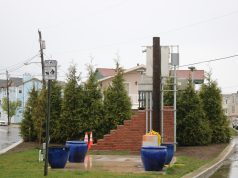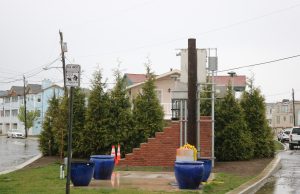The following is an open letter from the commander of the U.S. Army Corps of Engineers Philadelphia District in response to an oft-heard complaint about the ongoing beach replenishment work in the vacation season — “Why does it have to be during the summer?!”
In Ocean City, a project to rebuild beaches and dunes between 37th Street and 59th Street began in mid-April, but an 11-week dredge repair left all beaches open through June, July and the first part of August. For more information and daily updates on the progress of work, visit OCNJ Daily’s Beach Replenishment Update.
To both residents and visitors along the Jersey shore, I would like to thank you for bearing with us as we work to build more dunes and fill more beaches to reduce damages from future storms. We understand how inconvenient a 24/7 construction job can be during the peak vacation season, and I can assure you we are working as fast as we can to complete all the projects.
Unfortunately, in the wake of the devastation that Sandy left along the Jersey Shore, elected officials and the overwhelming majority of citizens alike recognize the importance of constructing these vital projects, which are designed to reduce storm damages to infrastructure. Yet many still inevitably ask, “OK… but why does it have to be during the summer?!”
It’s a fair question, and one we’ve heard frequently this year. The answer is that there are multiple factors involved in project timing, but these are the most critical:
- FEDERAL FUNDING: As many of you know, Congress provided funding under the Hurricane Sandy Relief Act (Public Law 113-2), that enabled us to move forward in tandem with our partner and sponsor, the state of New Jersey, on a large number of projects, unprecedented in their scope. While this funding was not tied to one particular year, it still carries the expectation of being put to its intended use as soon as possible.
- REAL ESTATE: The timing of the real estate acquisition process has a tremendous impact on the rest of a project’s schedule. We need all necessary real estate rights to legally construct a project before awarding a construction contract.
- PROJECT SIZE: A large project means a large contract, for which we have to provide private industry with an ample amount of time—often in excess of 300 days—to complete the work. Inevitably, some of this work, at some locations, will take place during the summer. If we don’t provide enough time, we risk receiving bids that are too high for us to consider, or receiving no bids at all.
- EQUIPMENT AVAILABILITY: It’s also important to note there is a limited number of dredges that can handle beachfill operations. And for the dredging industry, their safest and most efficient use of these dredges is often during the summer, because of calmer seas. In addition, these same dredges already do most of the large navigation projects within U.S. waters, and when there is a large amount of emergency beachfill or channel dredging, the demand inevitably exceeds the supply. So if we specifically exclude summer work, we again risk pricing ourselves out of the bidding market and not being able to build these projects at all.
- MISSION URGENCY: Lastly, our mission in these projects is to protect communities by reducing the risk of storm damages, whether from a September hurricane or a March nor’easter. Once a project is ready to build, we have a clear responsibility to do so—as opposed to leaving any community exposed any longer than necessary.
Ideally we try to avoid summer beach nourishment. Not only do we work closely with the state and municipalities, but many members of our own team live or vacation at the shore—they are fully aware of the economic importance of this season. But for the reasons listed above, they also know we can’t always meet this ideal.
However, there are some things we have tried to soften the impact. First, during construction we close no more than 1,000 feet of beach at a time; this allows continued access for beachgoers by detouring no more than a block or two from any given point. We’ve also been posting daily updates to our website to notify people of any closures.
We know this doesn’t eliminate the inconvenience, but hopefully at least makes it more manageable.
The good news is we have made great progress on two projects. Our contractor Great Lakes Dredge & Dock Company is close to completing the Great Egg Harbor Inlet to Townsends Inlet project (which includes South Ocean City, Strathmere and Sea Isle City). And on Long Beach Island, we have placed 4.7 of the total 8 million cubic yards of sand as part of the project. Additionally, we are working closely with the state of New Jersey to move toward construction on other projects.
Again, I would like to thank the shore community for their cooperation and understanding. Our goal is to get these projects in place and doing their job of making your communities safer from this point forward.
By Lieutenant Colonel Michael Bliss, Commander
U.S. Army Corps of Engineers, Philadelphia District





